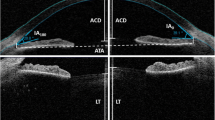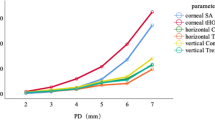Abstract
Objective
To evaluate the repeatability of the optical coherence tomography (OCT) retinal shape measurement with and without alignment correction in children and adults.
Methods
62 eyes of the 31 subjects were examined on the OCT with auto-alignment and alignment correction functions. We performed three measurements on each eye, created 2D retinal height maps, and extracted horizontal and vertical profiles for repeatability analysis and Legendre polynomial representation. Repeatability was determined from the average standard deviation. We estimated the refractive errors produced by the observed alignment errors. We also examined the repeatability improvement of the slopes, curvatures, and higher-order coefficients for the subjects using the Student t test.
Results
Repeatability was higher in the data with alignment. We observed the average repeatability in the child group with standard deviation (SD) equal 38.20 µm in raw data, and SD = 6.11 µm in the corrected data, in adults SD = 17.04 µm in raw data, and SD = 5.22 µm in the corrected data. The slope repeatability improved in both child [horizontal t (18) = 4.62, p < 0.001 and vertical t (17) = 4.43, p < 0.001] and adult groups [t (18) = 2.73, p = 0.007 and vertical t (26) = 2.14, p = 0.02], while higher-order coefficients were not affected.
Conclusions
Alignment correction improved repeatability of the OCT retinal shape measurements, especially for child subjects. Curvature and higher-order distortions were not affected by the alignment error. The refractive errors produced by alignment errors are low, and the model can be used to estimate the peripheral refraction.






Similar content being viewed by others
References
Foster, P.J., Jiang, Y.: Epidemiology of myopia. Eye (Basingstoke). 28, 202–208 (2014). https://doi.org/10.1038/eye.2013.280
Wu, P.-C., Huang, H.-M., Yu, H.-J., Fang, P.-C., Chen, C.-T.: Epidemiology of Myopia. Asia-Pac. J. Ophthalmol. 5, 386–393 (2016). https://doi.org/10.1097/APO.0000000000000236
Morgan, I.G., French, A.N., Ashby, R.S., Guo, X., Ding, X., He, M., Rose, K.A.: The epidemics of myopia: aetiology and prevention. Prog. Retinal. Eye. Res. 62, 134–149 (2018). https://doi.org/10.1097/10.1016/j.preteyeres.2017.09.004
Holden, B.A., Fricke, T.R., Wilson, D.A., Jong, M., Naidoo, K.S., Sankaridurg, P., Wong, T.Y., Naduvilath, T.J., Resnikoff, S.: Global prevalence of myopia and high myopia and temporal trends from 2000 through 2050. Ophthalmology. 123, 1036–1042 (2016). https://doi.org/10.1016/j.ophtha.2016.01.006
Haarman, A.E.G., Enthoven, C.A., Willem Tideman, J.L., Tedja, M.S., Verhoeven, V.J.M., Klaver, C.C.W.: The complications of myopia: a review and meta-analysis. Investig. Ophthalmol. Vis. Sci. 61(4), 49 (2020). https://doi.org/10.1016/10.1167/iovs.61.4.49
American Optometric Association. Evidence-based clinical practice guideline: comprehensive pediatric eye and vision examination. Optom. Clin. Pract. 2(2) (2020). https://doi.org/10.37685/uiwlibraries.2575-7717.2.2.1007
Wolffsohn, J.S., Flitcroft, D.I., Gifford, K.L., Jong, M., Jones, L., Klaver, C.C.W., Logan, N.S., Naidoo, K., Resnikoff, S., Sankaridurg, P., Smith, E.L., Troilo, D., Wildsoet, C.F.: IMI—myopia control reports overview and introduction. Invest. Ophthalmol. Vis. Sci. 60, M1–M19 (2019). https://doi.org/10.1167/iovs.18-25980
Atchison, D.A., Jones, C.E., Schmid, K.L., Pritchard, N., Pope, J.M., Strugnell, W.E., Riley, R.A.: Eye shape in emmetropia and myopia. Invest. Ophthalmol. Vis. Sci. 45, 3380–3386 (2004). https://doi.org/10.1167/iovs.04-0292
Guo, X., Xiao, O., Chen, Y., Wu, H., Chen, L., Morgan, I.G., He, M.: Three-dimensional eye shape, myopic maculopathy, and visual acuity: the zhongshan ophthalmic center-brien holden vision institute high myopia cohort study. Ophthalmology 124, 679–687 (2017). https://doi.org/10.1016/j.ophtha.2017.01.009
Wakazono, T., Yamashiro, K., Miyake, M., Hata, M., Miyata, M., Uji, A., Nakanishi, H., Oishi, A., Tamura, H., Ooto, S., Tsujikawa, A.: Time-course change in eye shape and development of staphyloma in highly myopic eyes. Invest. Ophthalmol. Vis. Sci. 59, 5455–5461 (2018). https://doi.org/10.1167/iovs.18-24754
Ciller, C., Zanet, D., Rüegsegger, S.I., Pica, M.B., Sznitman, A., Thiran, R., Maeder, J.-P., Munier, P.L., Kowal, F.L., Cuadra, J.H.: Automatic segmentation of the eye in 3D magnetic resonance imaging: a novel statistical shape model for treatment planning of retinoblastoma. Int. J. Radiat. Oncol. Biol. Phys. (2015). https://doi.org/10.7892/boris.65805
Lim, L.S., Yang, X., Gazzard, G., Lin, X., Sng, C., Saw, S.M., Qiu, A.: Variations in eye volume, surface area, and shape with refractive error in young children by magnetic resonance imaging analysis. Invest. Ophthalmol. Vis. Sci. 52, 8878–8883 (2011). https://doi.org/10.1167/iovs.11-7269
Lee, K.M., Park, S.W., Kim, M., Oh, S., Kim, S.H.: Relationship between three-dimensional magnetic resonance imaging eyeball shape and optic nerve head morphology. Ophthalmology. 128, 532–544 (2021). https://doi.org/10.1016/j.ophtha.2020.08.034
Moriyama, M., Ohno-Matsui, K., Hayashi, K., Shimada, N., Yoshida, T., Tokoro, T., Morita, I.: Topographic analyses of shape of eyes with pathologic myopia by high-resolution three-dimensional magnetic resonance imaging. Ophthalmology. 118, 1626–1637 (2011). https://doi.org/10.1016/j.ophtha.2011.01.018
Pope, J.M., Verkicharla, P.K., Sepehrband, F., Suheimat, M., Schmid, K.L., Atchison, D.A.: Three-dimensional MRI study of the relationship between eye dimensions, retinal shape and myopia. Biomed. Opt. Express. 8, 2386 (2017). https://doi.org/10.1364/boe.8.002386
Ohno-Matsui, K., Akiba, M., Modegi, T., Tomita, M., Ishibashi, T., Tokoro, T., Moriyama, M.: Association between shape of sclera and myopic retinochoroidal lesions in patients with pathologic myopia. Invest. Ophthalmol. Vis. Sci. 53, 6046–6061 (2012). https://doi.org/10.1167/iovs.12-10161
Kuo, A.N., Verkicharla, P.K., McNabb, R.P., Cheung, C.Y., Hilal, S., Farsiu, S., Chen, C., Wong, T.Y., Kamran Ikram, M., Cheng, C.Y., Young, T.L., Saw, S.M., Izatt, J.A.: Posterior eye shape measurement with retinal OCT compared to MRI. Invest. Ophthalmol. Vis. Sci. (2016). https://doi.org/10.1167/iovs.15-18886
Kuo, A.N., McNabb, R.P., Izatt, J.A.: Advances in whole-eye optical coherence tomography imaging. Asia. Pac. J. Ophthalmol. 8(2), 99–104 (2019). https://doi.org/10.22608/APO.201901
Atchison, D.A., Pritchard, N., Schmid, K.L.: Peripheral refraction along the horizontal and vertical visual fields in myopia. Vision. Res. 46, 1450–1458 (2006). https://doi.org/10.1016/j.visres.2005.10.023
Benavente-Pérez, A., Nour, A., Troilo, D.: Axial eye growth and refractive error development can be modified by exposing the peripheral retina to relative myopic or hyperopic defocus. Invest. Ophthalmol. Vis. Sci. 55, 6765–6773 (2014). https://doi.org/10.1167/iovs.14-14524
Smith, E.L., Hung, L.F., Huang, J., Blasdel, T.L., Humbird, T.L., Bockhorst, K.H.: Effects of optical defocus on refractive development in monkeys: evidence for local, regionally selective mechanisms. Invest. Ophthalmol. Vis. Sci. 51, 3864–3873 (2010). https://doi.org/10.1167/iovs.09-4969
Zhang, H.Y., Lam, C.S.Y., Tang, W.C., Leung, M., To, C.H.: Defocus incorporated multiple segments spectacle lenses changed the relative peripheral refraction: A 2-year randomized clinical trial. Invest. Ophthalmol. Vis. Sci. (2020). https://doi.org/10.1167/IOVS.61.5.53
Zhu, Q., Liu, Y., Tighe, S., Zhu, Y., Su, X., Lu, F., Hu, M.: Retardation of myopia progression by multifocal soft contact lenses. Int. J. Med. Sci. 16(2), 198–202 (2019). https://doi.org/10.7150/ijms.30118
Gifford, K.L., Gifford, P., Hendicott, P.L., Schmid, K.L.: Stability of peripheral refraction changes in orthokeratology for myopia. Cont. Lens Anterior. Eye. 43, 44–53 (2020). https://doi.org/10.1016/j.clae.2019.11.008
von Helmholtz, H.: Helmholtz`s treatise on physiological optics. Thoemmes Continuum, Bristol (2000)
Aboites, V.: Legendre polynomials: a simple methodology. J. Phys. Conf. Ser. (2019). https://doi.org/10.1088/1742-6596/1221/1/012035
Helo, A., Pannasch, S., Sirri, L., Rämä, P.: The maturation of eye movement behavior: scene viewing characteristics in children and adults. Vision. Res. 103, 83–91 (2014). https://doi.org/10.1016/j.visres.2014.08.006
Verkicharla, P.K., Mathur, A., Mallen, E.A.H., Pope, J.M., Atchison, D.A.: Eye shape and retinal shape, and their relation to peripheral refraction. Ophthalmic. Physiol. Opt. 32(3), 184–199 (2012). https://doi.org/10.1111/j.1475-1313.2012.00906.x
Acknowledgements
This work was supported by the R&D Department, Topcon Co, Tokyo, Japan, and the Department of Ophthalmology at the University of Tsukuba, Tsukuba, Japan. The sponsor did not influence the research outcomes.
Author information
Authors and Affiliations
Contributions
Commercial relationships: Topcon Co: TM (E), JL (E), TO (F).
Corresponding author
Additional information
Publisher's Note
Springer Nature remains neutral with regard to jurisdictional claims in published maps and institutional affiliations.
Rights and permissions
About this article
Cite this article
Palchunova, K., Mino, T., Mihashi, T. et al. Precise retinal shape measurement by alignment error and eye model calibration. Opt Rev 29, 188–196 (2022). https://doi.org/10.1007/s10043-022-00733-4
Received:
Accepted:
Published:
Issue Date:
DOI: https://doi.org/10.1007/s10043-022-00733-4




